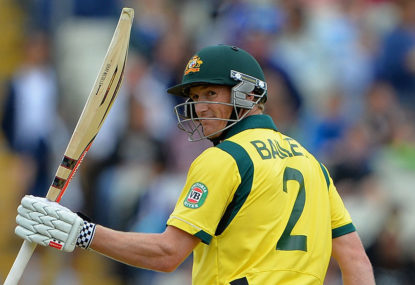There is a widely-held opinion among cricket followers that batting performances in one day internationals should be ignored when considering Test selections.
It is far too simplistic a view.
It fails to take into account the varied approaches of different batsmen in ODIs or the plethora of match situations and pitch conditions they can encounter in that format.
Undoubtedly, runs scored in certain styles or circumstances have no relevance to a batsman’s potential capacity to succeed at Test level.
Dazzling the crowd with a slog-laden innings on benign decks in India gives no indication of your preparedness to tackle Dale Steyn, Vernon Philander and Morne Morkel on a seaming Test deck in South Africa.
Some batsmen, however, display in their ODI efforts qualities which are crucial at Test level – circumspection, composure, and the ability to bat at different tempos within the same innings.
The difference between relevant and irrelevant runs at ODI level can be summed up by comparing George Bailey and Aaron Finch.
The latter was mentioned in some quarters as a potential Test batsman in the wake of his recent explosive efforts at the top of the order for Australia in India and England.
But the aggressive Victorian bats in a fashion incongruous with the longest form of the game.
Even early in his innings, he commonly clears his front leg T20-style to heave balls through or over the leg side.
Finch appears uncomfortable when he is not dictating terms to the bowler.
As such, when he is tied down for an over or two he tends to respond by trying to manufacture a boundary, even if the delivery is worthy of respect.
This impatience is also evident at first class level and has cruelled Finch to the point he averaged just 16 with the bat over the past two Sheffield Shield seasons.
Bailey, too, had a rough trot in the Shield last summer.
However, unlike Finch, he had previously displayed aptitude for first class cricket, having made 1876 runs at 43 in the three Shield seasons prior to that.
The Tasmanian skipper also pushed his case for a Test debut via his run-making in limited overs cricket.
In his past 15 ODI innings, Bailey has churned out a phenomenal 944 runs at 79.
Similar to Finch, the 31-year-old has shown the ability to vaporise opposition attacks with T20-inspired striking.
But those blitzkriegs have typically come in the second half of otherwise patient, well-paced innings.
Most importantly, Bailey has repeatedly shown he is capable of rescuing Australia from perilous situations.
He did this not with cavalier counter attacks but by building innings in a poised manner.
He weathered difficult periods and halted the opposition’s momentum before accelerating once well set.
Six of his first 11 scores above 50 in ODIs came when he arrived at the crease with Australia in disarray following an early collapse.
Those are the performances which suggested he was a reasonable option for the Test side, rather than his string of more eye-catching innings in India, when he cut loose after coming to the wicket with Australia well on top.
It should be remembered that prior to making his mark as one of the best ODI batsmen in the world, Bailey was an ordinary player in 50-over cricket for Tasmania.
He had averaged just 33 in List A cricket.
Bailey has shown that most valuable commodity among athletes – the capacity not just to adapt but to improve when given a chance at the highest level.
Many players have dominated domestic cricket only to flounder in international competition.
But Bailey has thrived under the greater pressure and scrutiny.
His performances in ODIs were rightly given some weight when the selectors considered their Ashes squad.
It does, however, remain questionable that he was picked almost solely on his ODI displays.
He should have been required, and given the opportunity, to provide solid evidence of his touch against the red ball.
Undoubtedly, tackling James Anderson, Stuart Broad and Graeme Swann in the blinding pressure of an Ashes series will prove a greater challenge than any he has encountered in coloured kits.





























































































